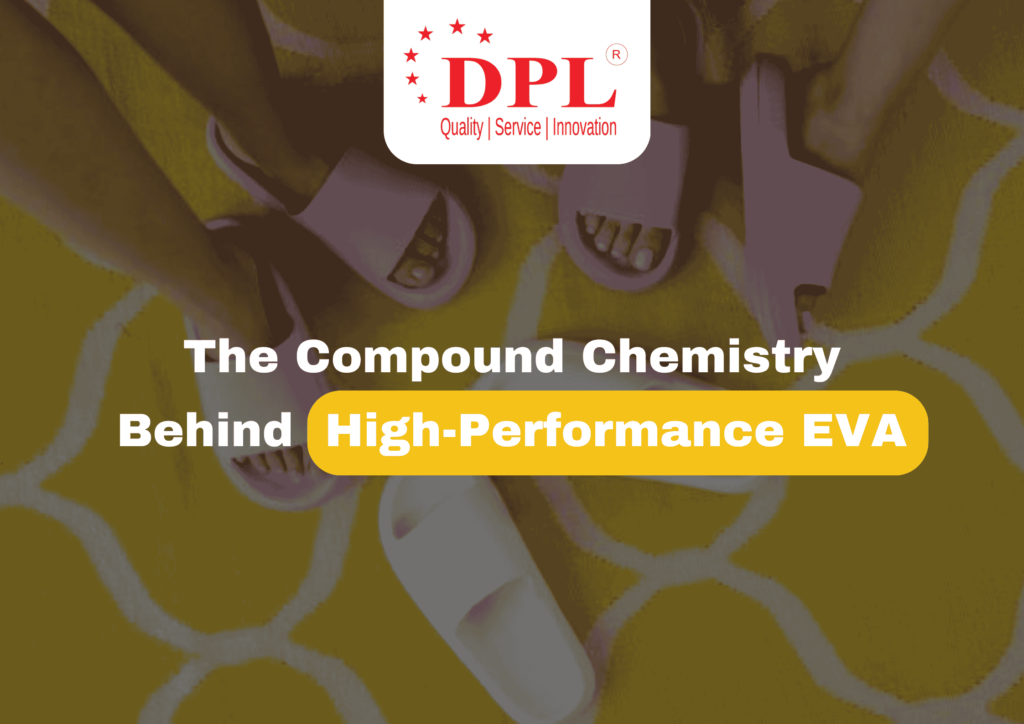
Ethylene Vinyl Acetate (EVA) has become a material of immense interest within the Indian polymer industry due to its balance of flexibility, toughness, and processability. While its widespread usage is well known, understanding the compound chemistry that enables EVA to deliver high performance offers deeper insights into its real potential. This article explores the fundamental molecular structure, co-polymerisation process, critical additives, and formulation strategies that give rise to high-performance EVA materials.
Introduction to EVA Chemistry
At its core, EVA is a copolymer of ethylene and vinyl acetate (VA). Ethylene serves as the backbone, imparting structural integrity and basic thermoplastic characteristics. Vinyl acetate, on the other hand, introduces polarity and flexibility due to its acetate side groups. The amount of vinyl acetate incorporated into the polymer chain significantly influences the final properties of the EVA resin.
The general structure of EVA can be expressed as:
–[CH₂–CH₂]_x–[CH₂–CH(OCOCH₃)]_y–
Here, x and y represent the mole fractions of ethylene and vinyl acetate respectively. The ratio between these two determines whether the material behaves more like polyethylene or a rubbery thermoplastic.
Role of Vinyl Acetate Content
The vinyl acetate (VA) content in EVA typically ranges from 5% to 40% by weight. This variation allows for customisation of the material’s softness, clarity, elasticity, and polarity.
● Low VA Content (5–10%): The polymer behaves similarly to polyethylene, exhibiting high tensile strength and stiffness.
● Medium VA Content (10–25%): The balance between rigidity and flexibility begins to shift, offering improved toughness and clarity.
● High VA Content (25–40%): The polymer becomes significantly more flexible and rubber-like, with enhanced impact resistance and transparency.
In high-performance EVA, a carefully controlled VA content usually between 18% and 33% ensures optimal elasticity, durability, and environmental resistance without sacrificing dimensional stability.
Molecular Weight and Branching
Apart from VA content, the molecular weight and chain architecture of EVA play crucial roles in determining its mechanical and thermal properties.
● High Molecular Weight: Leads to better tensile properties and melt strength but can be more difficult to process.
● Controlled Branching: Long-chain branching in EVA enhances melt strength and elasticity, which is particularly beneficial during extrusion and moulding.
By precisely tailoring these molecular features during polymerisation, manufacturers can create EVA grades that meet stringent performance criteria for various industrial settings.
Polymerisation Process
EVA is typically produced via high-pressure radical polymerisation using a tubular or autoclave reactor system. The copolymerisation of ethylene and vinyl acetate occurs in the presence of free-radical initiators such as peroxides. This method allows for a controlled VA content and desired molecular structure.
Key aspects of the polymerisation include:
● Temperature and Pressure Control: Maintains consistent reaction conditions to ensure even VA distribution across polymer chains.
● Initiator Selection: Impacts molecular weight and branching characteristics.
● Reaction Time: Longer polymerisation can enhance molecular weight but may also increase gel content.
Optimisation at this stage is critical to ensure the EVA compound’s processability and performance in its final form.
Importance of Additives in High-Performance EVA
Raw EVA resin alone may not suffice for high-performance requirements. Additives play a pivotal role in tailoring the compound’s behaviour during processing and end-use. These additives are carefully selected to address Indian climatic conditions, manufacturing preferences, and regulatory compliance.
a) Stabilisers
EVA is sensitive to thermal degradation, particularly during high-temperature processing. Thermal stabilisers, such as phosphites and hindered phenols, are added to prevent oxidation and maintain polymer integrity.
b) Antioxidants
To improve the polymer’s lifespan, primary and secondary antioxidants are included. These inhibit oxidative degradation caused by heat, UV radiation, and mechanical stress.
c) UV Absorbers and Hindered Amine Light Stabilisers (HALS)
For outdoor durability, especially under Indian sunlight conditions, UV stabilisers prevent polymer breakdown and yellowing.
d) Processing Aids
These help improve melt flow, reduce die build-up, and enable uniform surface finish. Common aids include metal stearates and fluoropolymers.
e) Fillers and Reinforcements
In some formulations, mineral fillers like calcium carbonate or silica may be added to enhance dimensional stability and reduce cost, while maintaining required mechanical properties.
Crosslinking Chemistry in EVA
To further enhance performance, especially under thermal or mechanical stress, crosslinking is employed. Crosslinking transforms EVA from a thermoplastic to a thermoset-like material, significantly boosting its heat resistance, mechanical strength, and resilience.
There are three main approaches:
Peroxide Crosslinking
Organic peroxides such as dicumyl peroxide (DCP) are commonly used. Upon heating, these compounds decompose to form free radicals, which induce crosslinking between EVA chains.
● Advantages: Uniform network formation and high thermal resistance.
● Challenges: Requires precise temperature control to avoid scorching or incomplete curing.
Silane Crosslinking
Vinyl silane-functionalised EVA is grafted and later crosslinked using moisture and a catalyst. This method is effective in environments where post-processing exposure to moisture is feasible.
● Advantages: Room-temperature curing and good process control.
● Limitations: Requires additional grafting and hydrolysis steps.
Radiation Crosslinking
Gamma or electron-beam radiation creates active sites on polymer chains, leading to crosslinking. This is suitable for precise and controlled modifications but is cost-intensive and requires safety protocols.
Blend Modifications for Enhanced Properties
High-performance EVA compounds often contain other polymers to improve specific attributes:
● EVA–LDPE Blends: Improve stiffness while retaining flexibility.
● EVA–Rubber Blends: Increase impact resistance and elasticity.
● EVA–Polypropylene Blends: Enhance chemical resistance and temperature stability.
These blends are fine-tuned to ensure homogeneity, compatibility, and balanced properties. In the Indian context, such modifications are increasingly preferred for better climate adaptability and value engineering.
Conclusion
High-performance EVA is not a result of mere raw polymer usage, but a product of meticulous compound chemistry. From controlling vinyl acetate content and molecular weight to selecting the right stabilisers, crosslinking agents, and processing aids, every step in the compounding process plays a decisive role.
For Indian manufacturers, especially those operating in diverse climates and regulatory environments, understanding this chemistry is key to delivering durable, high-quality EVA compounds. The DPL Group of Companies continues to invest in R&D and innovation in polymer chemistry to ensure that our EVA materials consistently exceed industry expectations and adapt seamlessly to future material demands.
